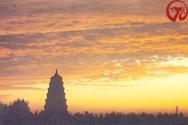 |
The Wild Goose Pagoda, located at the southern end of the Great Compassion Temple, has become a symbol of Xi’an, a former historical capital of China. Wild Goose Pagoda was built for Monk Tang Sanzang to organise and translate the Buddhist scriptures that he brought back from India. Wild Goose Pagoda was originally named Goose Pagoda after a similar pagoda in India. Later on, a smaller Goose Pagoda was built inside the Blessings Temple of Changan City. In order to distinguish between the two, people call the one in the Great Compassion Temple Wild Goose Pagoda and the one in the Blessings Temple Small Goose Pagoda.
Wild Goose Pagoda is built on a 16-foot high, 147-foot square platform. It is a squared-shape pagoda with seven-floors and is approximately 210 feet tall. The bottom floor covers an 82 square foot area. The whole structure is made of solid bricks with a circular staircase to the top. Each floor has four arch gates, one on each side. From the top, the entire city of Changan lays revealed before your eyes.
The bottom floor has a stone gate decorated with fine engravings of Buddha statues. It is said that they were painted by Mr. Yan Liti, a well-known Chinese artist from Tang Dynasty. Two stone tablets are mounted inside brick cages along the two sides of the southern entrance door. One tablet is engraved with the, “Preface of the Great Tang Sanzang Scriptures,” while the other is engraved with Emperor Tang Gaozong’s “Notes on the Preface of the Great Tang Sanzang Scriptures.” Both of them were from the calligraphy of Mr. Zhu Suiliang, one of the four most famous Chinese calligraphers at the beginning of China’s Tang Dynasty. The tablets are bordered with beautiful and vivid vine-like designs. The pagoda preserves some important artifacts of calligraphy, painting and scriptures from China’s Tang Dynasty. Through the years of the Tang Dynasty, most of the temples were destroyed during times of war. The Wild Goose Pagoda is the only one that remains standing until today.
Wild Goose Pagoda was originally only five-stories high. It was first remodelled by Queen Wu Zetian in the Tang Dynasty and this was followed by several other major facelifts. The pagoda has an overall appearance of a cone-shaped building but each floor has a square design. The pagoda is made of gray bricks that imitate wooden columns and borders. It is regarded as one of the masterpieces among the Buddhist temples.
The Great Compassion Temple is the most magnificent temple in Changan City. It was built by order of Princess Li Zhi of the Tang Dynasty. Monk Tang Sanzang was the head administrator and was in charge of the effort to translate the Buddhist scriptures. He also oversaw the construction of the Wild Goose Pagoda.
Inside the temple a bell tower and a drum tower face each other. The bell and drum were used to send messages for people to follow. The old saying, “Bell charms at dawn and drum beats at dusk,” gives a perfect description of the Buddhist lives at the temple. At the east side of the temple a 3-meter-tall bell, weighing approximately 15,000 kg (16.5 tons) hangs right in the middle of the bell tower. Traditionally, newly promoted officials for the imperial court would visit this temple and leave their signatures at the tower. This is the well-known “Wild Goose Pagoda signature.”
Other famous artists in Tang Dynasty such as Wu Daozi and Wang Wei also contributed masterpieces to the temple. Unfortunately these relics have vanished before our time. Only the ones on the beams and frames over the doorways are kept today. The most precious piece is the engraved picture, “Palace” on the beam of the west doorway.
A group of smaller pagodas with the tombs of monks were built at the southeast side of the Wild Goose Pagoda. Six of them were built in Qing Dynasty. The centrepiece, “The Great Hall of Solemnity” with clay statues of Buddhas and Bodhisattva's is the place where monks chant Buddhist scriptures, while the “Law Court” is used to interpret and learn Buddhist scriptures. A bronze statue of Buddha Amitabha resides inside the “Law Court.”
* * *
You are welcome to print and circulate all articles published on Clearharmony and their content, but please quote the source.










 more ...
more ...